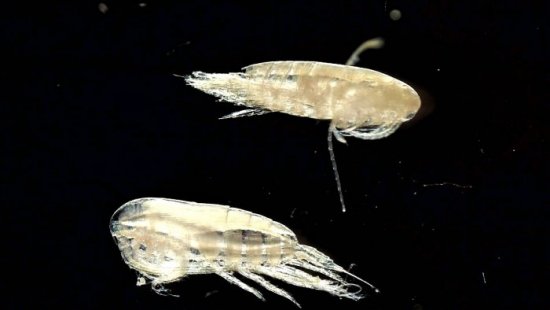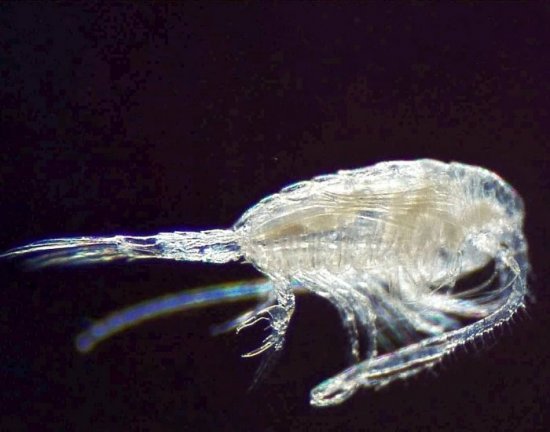
Valider la capacité d’un échosondeur de pêche fixé sur un planeur à mesurer la concentration de mésozooplancton dans toute la colonne d’eau
– Par Delphine Mossman, Candidate de M.Sc., Univesité de Nouveau-Brunswick –
Malgré la petite taille de ses organismes, le mésozooplancton constitue l’un des groupes d’animaux les plus importants de la planète. Il joue un rôle important dans de nombreux cycles biogéochimiques qui ont des répercussions sur la planète, agit comme régulateur des populations de phytoplancton et constitue une source importante de nourriture pour une multitude de créatures marines, des petits poissons aux plus grands organismes de la planète, comme les baleines à fanons. Il est essentiel de comprendre l’abondance et la distribution du zooplancton – ainsi que son évolution dans le temps – afin de comprendre l’écosystème océanique mondial.
Malheureusement, mesurer le zooplancton n’est pas sans difficulté, la principale étant l’immensité de l’océan. De nombreuses techniques d’échantillonnage ont été mises au point pour recueillir des informations (filets, compteurs optiques de plancton, équipement d’imagerie du plancton, échosondeurs, pour ne citer que les plus importantes), mais leur portée est limitée du fait qu’elles doivent être déployées à partir d’un bateau. Les bateaux sont coûteux à affréter et à entretenir, et leur couverture temporelle et spatiale est relativement limitée; la plupart des déploiements de navires sont de l’ordre de quelques jours à quelques semaines et ne couvrent qu’un à cent kilomètres carrés. C’est pourquoi le zooplancton est l’un des organismes les plus sous-échantillonnés de l’océan, bien qu’il soit l’un des plus répandus.
Mes travaux portent sur le problème nouveau de la mesure spécifique de couches de diffuseurs faibles avec un échosondeur de pêche fixé sur un planeur. Fixer un échosondeur – méthode déjà utilisée pour mesurer les concentrations de zooplancton dans la colonne d’eau – sur un planeur (un sous-ensemble de véhicules sous-marins autonomes propulsés par un moteur à flottabilité) permet à ce dernier de se déplacer librement dans la colonne d’eau, amenant l’échosondeur jusqu’aux couches de plancton les plus profondes. Si les résultats démontrent que les planeurs sont capables de mesurer avec précision le zooplancton de différentes tailles dans toute la colonne d’eau, nous pourrons recueillir de grandes quantités de données sur ces organismes et les conditions océaniques à un coût relativement faible par rapport aux méthodes de collecte de données par bateau. Cette méthode innovante de collecte de données permettrait de résoudre le problème du sous-échantillonnage du zooplancton et pourrait conduire à de nouvelles découvertes dans un grand nombre de domaines, de la biologie à l’océanographie chimique en passant par l’écologie, en élargissant notre connaissance du monde naturel et de certains des animaux les plus répandus.
Validating the ability of a glider-mounted fisheries echosounder to measure mesozooplankton concentration throughout the water column
– By Delphine Mossman, Candidate de M.Sc., Univesité de Nouveau-Brunswick –
Despite their diminutive size, zooplankton are among the most important groups of animals on the planet. They are key players in many biogeochemical cycles that affect the globe, act as regulators of phytoplankton populations, and are an important source of food for a host of marine creatures, from small fish to the largest organisms on earth: the baleen whales. There is also a great deal of diversity within the zooplankton community, including adult organisms such as jellyfish, salps, and copepods, but also larval stages of many animals that become nektonic (free swimmer) or benthic (bottom swimers) in adulthood. Because of their diversity in role and species, understanding the abundance and distribution of zooplankton—and how it changes over time—is an essential part of our understanding of the global ocean ecosystem.

Unfortunately, measuring zooplankton is not without its difficulties, chief among them being the sheer size of the ocean. It is clearly impossible to sample every cubic meter of the ocean to determine the exact population sizes of zooplankton, and therefore sampling techniques need to be used, but even obtaining a representative sample is a logistical challenge. Zooplankton tend to aggregate in thin, depth-stratified layers not usually visible from the surface. Many sampling techniques have been developed to collect information—net-based tows, optical plankton counters, plankton imaging equipment, and echosounders, to name the most prominent ones—but these are limited in scope by their need to be deployed from a vessel. Vessels are expensive to charter and maintain, and cover relatively small amounts of time and space; indeed most vessel deployments are on the order of days to weeks, covering only one to one hundred square kilometers. The ultimate result of these shortcomings is that zooplankton are some of the most under-sampled organisms in the ocean, despite being some of the most widespread.
The concurrent development of autonomous underwater vehicle (AUV) technology and smaller, lighter, power-saving sensors could be the key to cost-efficient methods of big data collection about zooplankton abundance and distribution. In particular, AUVs propelled by buoyancy engines (a subset of AUVs known as gliders) pair very well with fishery echosounders, which have already been used as a tool for measuring zooplankton concentrations in the water column. However, both hull-mounted and vessel-towed fishery echosounders are limited in the depths they can sample, due to attenuation of the transmitted sound over distance: this constraint has limited their usage in measuring deep layers of zooplankton. Attenuation becomes especially egregious for high frequencies, which are necessary to sample the smallest zooplankton such as copepods. Mounting an echosounder on a glider, on the other hand, uncouples it from this depth limitation, since the glider is free to move up and down in the water column, bringing the echosounder to the deepest plankton layers.

My work focuses on the novel problem of specifically measuring layers of weak scatterers with a glider-mounted fishery echosounder. Previous glider-mounted echosounder studies have focused on measuring larger zooplankton such as krill (euphausiid) species, but this would be the first study to try and use one to measure smaller, weak scatterers deep in the ocean. If this work successfully demonstrates that gliders are capable of accurately measuring zooplankton of a variety of sizes throughout the water column, then it would introduce the ability to collect large amounts of data about zooplankton and oceanic conditions at relatively low cost compared to vessel data collection methods. Gliders can be deployed for weeks to months at a time with minimal human input, covering a vast area of the ocean at a much lower cost than deploying a vessel over the same area. This innovative data collection method would put a significant dent in the zooplankton undersampling problem and potentially lead to novel discoveries in a wide variety of fields from biology to chemical oceanography to ecology by expanding our knowledge of the natural world and some of the most widely distributed animals in it.
Biologie des océans, échosondeur sur un planeur, Surveillance des océans, Technologie océanique